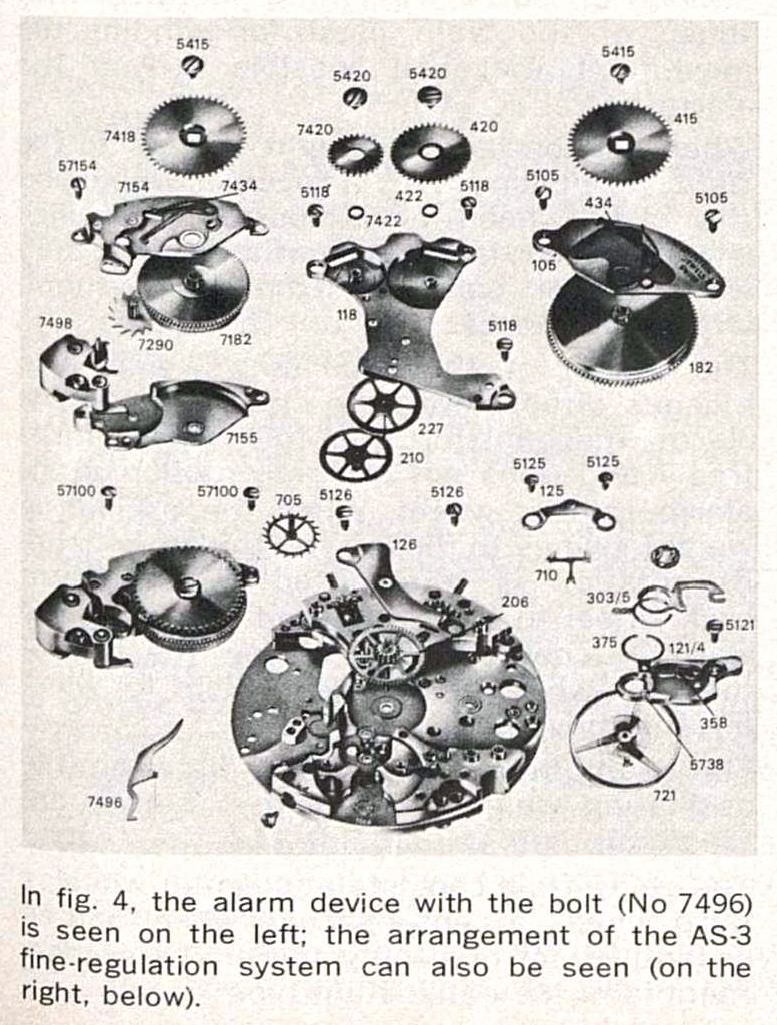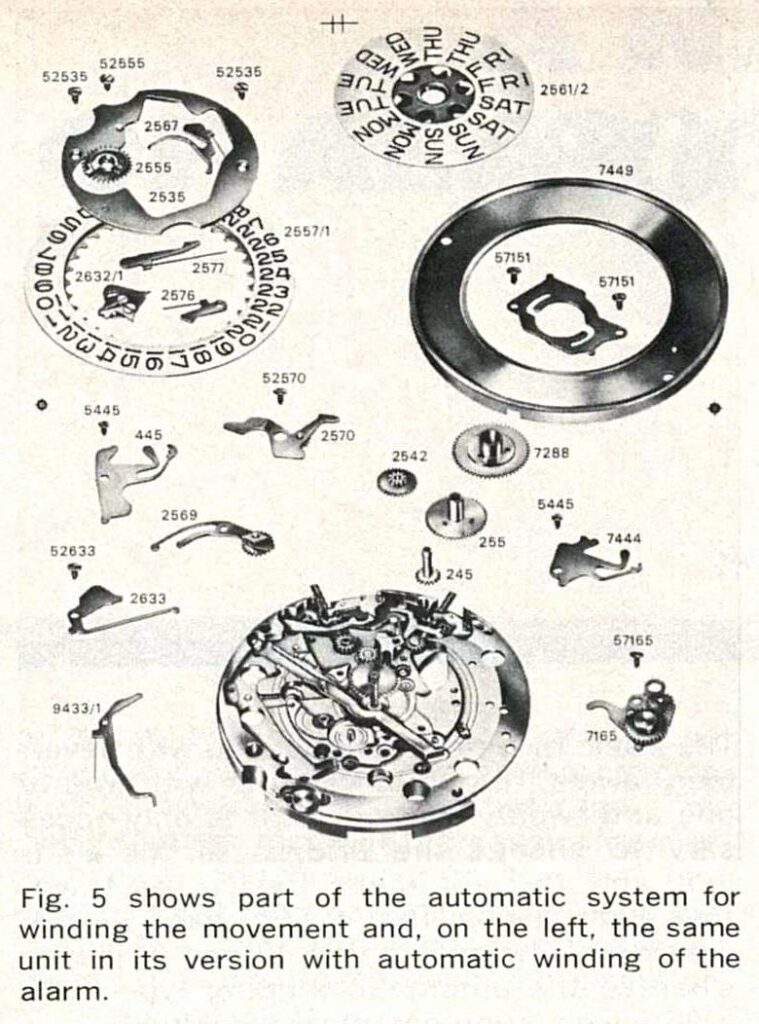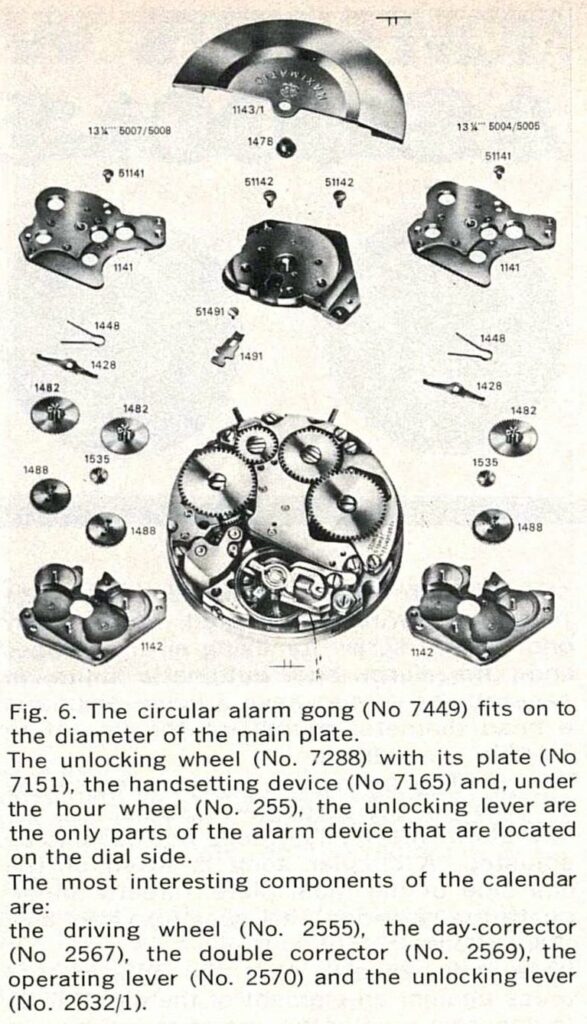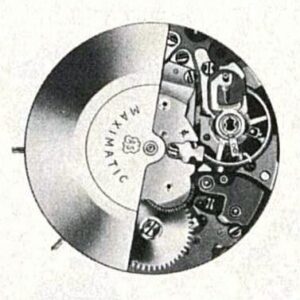 |
Brand: | A. Schild | 





|
|---|---|---|---|
| Family: | |||
| Height: | 7.60 mm | ||
| Jewels: | 17, 31 | ||
| Reserve: | 40 hours | ||
| Frequency: | 28,800 A/h | ||
| Winding: | Automatic, Central Rotor Automatic Winding, Uni-Directional Automatic Winding | ||
| Diameter: | 30.40 mm (13.25 ligne) | ||
| Complications: | Alarm, Date, Day, Hacking Seconds, Hand Winding, Quick Date Correction, Quick Day Correction | ||
| Hands: | Central Alarm Hand, Central Hour Hand, Central Minute Hand, Central Seconds Hand, Date Window at 3:00, Day Window at 3:00 | ||
| Distinguishing Technical Characteristics | |||||||||||
|---|---|---|---|---|---|---|---|---|---|---|---|
 Central-Rotor Automatic  Clockwise Balance Cock  Indexed Regulator |
|||||||||||
| Production: 1973 – 1977 | |||||||||||
| 1910s | 1920s | 1930s | 1940s | 1950s | 1960s | 1970s | 1980s | 1990s | 2000s | 2010s | 2020s |
A. Schild Cal. 5008 is an automatic movement with alarm function produced between 1973 and 1977. It found wide use in the 1970s, offering a function then unavailable in quartz models, and again in the 2000s as mechanical watches were once again prized. It is said that 175,891 examples were produced but only a small number were used in the 1970s. This is one reason that so many watches were produced in the 2000s with new old stock movements.
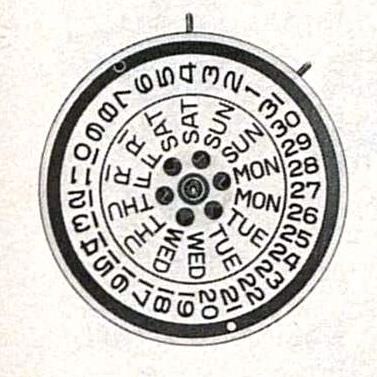
As is typical with many alarm watches, Cal. AS 5008 is a double-barrel movement. One barrel powers the timekeeping functions while a second powers the alarm chime. Unusually, the central automatic rotor winds both barrels, one in each direction. Most other automatic alarm movements, particularly the popular Jaeger-LeCoultre Memovox, require hand winding of the alarm. The A. Schild “Maximatic” uni-directional winding system is duplicated, with one operating in each direction for each barrel.
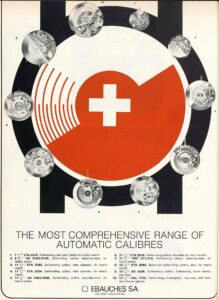
Another unusual element of the AS 5008 is the location of the gong. Rather than affix it to the back of the watch case, interfering with the winding rotor and access to the movement through the case back, it is placed between the movement and the dial of the watch. A. Schild recommended attaching one end of the gong to the outer case, below the bezel, to amplify the sound. The company claimed that a fully-wound alarm barrel would produce a 57 decibel alarm for 8 seconds.
A central hand is used to set the alarm on a 12-hour scale. A. Schild advised applying 144 marks to the dial, each indicating a 5-minute interval, to facilitate setting the alarm. The alarm is activated when the second crown is pulled out and silenced when it is pushed in, opposite the Jaeger-LeCoultre Memovox.
The basic movement had 17 jewels. A. Schild also supplied bridges for the automatic winding system and the alarm system, each with four additional jewels. This is the reason that the hand-winding AS 5001 movement was available in 17 or 21 jewel versions and the automatic movements with 17, 21, or 25 jewels.
Notable technical features include 28,800 A/h operation, direct center seconds, hacking seconds, hand winding, and the AS-3 indexed regulator. The regulator is of the classic A. Schild design, with a C-shaped device attached to a moving indicator and index. A. Schild designed the movements with modern manufacturing in mind, using the same screws for most components and supplying a special plate to facilitate working and finishing.
AS 5008 Operation
The time is indicated using central hour, minute, and seconds hands. Another central hand indicates the alarm time on a 12-hour scale. The day and date is traditionally indicated through windows at 3:00 on the dial.
There are two crowns:
- 2:00 “Crown A” for hand winding, setting the day and date, and setting the time
- 4:00 “Crown B” for winding the alarm and setting and activating it
Crown A Positions (Time and Calendar, 2:00)
- Hand winding (clockwise)
- Quick date correction (clockwise); quick day correction (counter-clockwise)
- Hacking seconds; correcting the time (clockwise to advance)
Crown B Positions (Alarm, 4:00)
- Alarm off; winding the alarm (clockwise)
- Alarm on; setting the alarm time (counter-clockwise)
Applications and Variants
Cal. AS 5008 was widely used in Swiss watches in the 1970s. Notable models came from brands like Aristo, Tell, and others.
In modern times it was used by Auguste Reymond, Girard-Perregaux, Maurice Lacroix, Montblanc, and Nivrel. Many of these later models have 31 jewels rather than the original 17. Many modern manufacturers also relocate the day and date to 12 and 6, respectively, and use a ball bearing rotor rather than a simple sleeve bearing.
- Auguste Reymond Cotton Club Alarm (1996) – Cal. AS 5008, day and date windows at 6:00
- Montblanc Meisterstück Rèveil Automatic (1999) – Cal. AS 5008, day at 12:00, date at 6:00
- Maurice Lacroix Masterpiece Rèveil (1990-2000) – Cal. ML20, day at 12:00, date at 6:00
- Girard-Perregaux Traveller II (2000) – Cal. GP 2291 with Jaquet-Baume 58.037 module, second timezone disc at 12:00 set using Crown A, date at 6:00
- Nivrel Automatic Alarm (2000) – Cal. AS 5008, day and date at 3:00
- Maurice Lacroix Réveil Globe (2002) – Cal. ML06 by Jaquet, second timezone 24-hour subdial at 6:00 set by a crown at 9:00, date window at 1:30
- Alain Silberstein Le Reveil GMT (2003) – second timezone 24-hour subdial at 6:00
- Louis Vuitton Tambour GMT Alarm (2006) – Cal. LV113 by La Joux-Perret, second timezone 24-hour disc at 6:00, date at 3:00
- Panerai Grantourismo GMT Alarm, FER 00016 (2007) – Cal. OP XXIV/La Joux-Perret 5900
- Panerai Radiomir GMT Alarm, PAM 046 (2001-2006) – Cal. GP 59
- Panerai Radiomir GMT Alarm, PAM 092 (2001-2006) – Cal. GP 59
La Joux-Perret LJP 5800 and 5900
Jaquet SA of La Chaux-de-Fonds purchased a large number of AS 5800 ebauches in the 1990s and began producing modified and remanufactured movements for a variety of companies. These were had at least 31 jewels and were generally fitted with a ball bearing rotor. Among the first to use these was Girard-Perregaux, who later called their movement Cal. GP 59.
By 2006, the company (renamed La Joux-Perret) began selling two new movements based on the AS 5008 design. Cal. LJP 5800 was a direct replacement, albeit with 31 jewels and a ball bearing rotor, while Cal. LJP 5900 added a GMT function. It is unclear if these movements use any original A. Schild components or are completely produced in-house.
A. Schild AS 5000 Family
A. Schild produced a family of alarm watch movements in the 1970s. Although the best-remembered version is the Cal. AS 5008, there were a total of five different movements produced.
| Calibre | Movement Winding | Alarm Winding | Calendar | Jewels |
|---|---|---|---|---|
| AS 5001 | Manual | Manual | Date Only | 17 or 21 |
| AS 5004 | Automatic | Manual | Date Only | 17, 21, or 25 |
| AS 5005 | Automatic | Manual | Day and Date | 17, 21, or 25 |
| AS 5007 | Automatic | Automatic | Date Only | 17, 21, or 25 |
| AS 5008 | Automatic | Automatic | Day and Date | 17, 21, or 25 |
Images in this article courtesy of Europa Star, issue 94, pages 72-74. Used with permission.
Images are taken from official publications and are used here for commentary and educational purposes. Copyright is held by the original owner as noted.